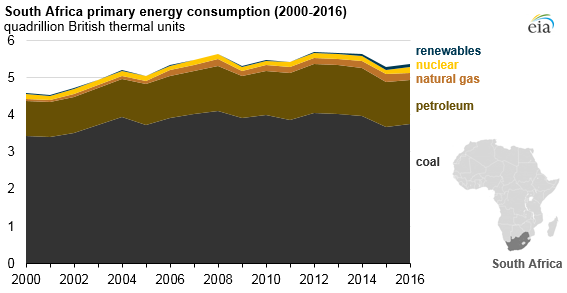South Africa Targets Gas and Renewables
South Africa, one of the world’s leading emitters of energy-related CO2, is looking to offshore gas to lessen its reliance on coal.
The nation ranked 15th globally in CO2 energy-related emissions in 2015, accounting for more than any other country in Africa. Its Intended National Determined Contribution, submitted as part of the Paris Agreement, plans for CO2 emissions to peak by 2025, remain flat for a decade and begin to decline around 2035.

South Africa relies primarily on coal for electricity generation, and coal accounted for about 70 percent of the country’s primary energy consumption in 2016. However, aging coal-fired power plants and insufficient investment in power infrastructure have led to recurring power outages. In response, South Africa plans to replace some of its outdated coal-fired capacity with nearly 10 gigawatts (GW) of supercritical coal units, which are more efficient because they operate at higher temperatures and pressures than conventional coal power plants. The country also plans to add more generating capacity fueled by natural gas and renewable energy by 2030.
Insufficient natural gas production and infrastructure have meant that consumers in the country must import a large portion of their supply. More than three-quarters of South Africa’s natural gas supply is transported by pipeline from Mozambique. In 2015, South Africa’s Department of Energy released a plan to construct nearly 4GW of natural gas-fired capacity that would be supplied by imported LNG from floating terminals at Richards Bay and Port Coega starting in 2020.
In addition to increasing LNG imports, the government plans to develop offshore natural gas fields, and one of the country's most viable opportunities for offshore field development is the Ibhubesi natural gas field, which is estimated to hold at least 540 billion cubic feet of recoverable reserves.
The U.S. Energy Information Administration estimates that South Africa holds 390 trillion cubic feet of onshore shale gas reserves, making it the eighth-largest holder of technically recoverable shale gas in the world. However, regulatory delays and technical difficulties have so far hindered shale gas development.
In an effort to increase the use of renewable energy, South Africa began a procurement program in 2011 to purchase power from renewable sources and lower-emitting energy plants funded by independent power producers. This program has added 3.3GW of renewable generation capacity to the grid so far, mostly from facilities fueled by wind and solar.
South Africa’s state-owned electricity firm, Eskom, also added large-scale wind and hydropower facilities since 2015 and currently operates 3.5GW of renewable energy capacity. South Africa's government aims to have 17.8 GW of renewable capacity on the grid by 2030, based on its latest energy plan.
